MERCEDES-BENZ GT R ROADSTER 2020 Owner's Manual
Manufacturer: MERCEDES-BENZ, Model Year: 2020, Model line: GT R ROADSTER, Model: MERCEDES-BENZ GT R ROADSTER 2020Pages: 470, PDF Size: 34.91 MB
Page 141 of 470
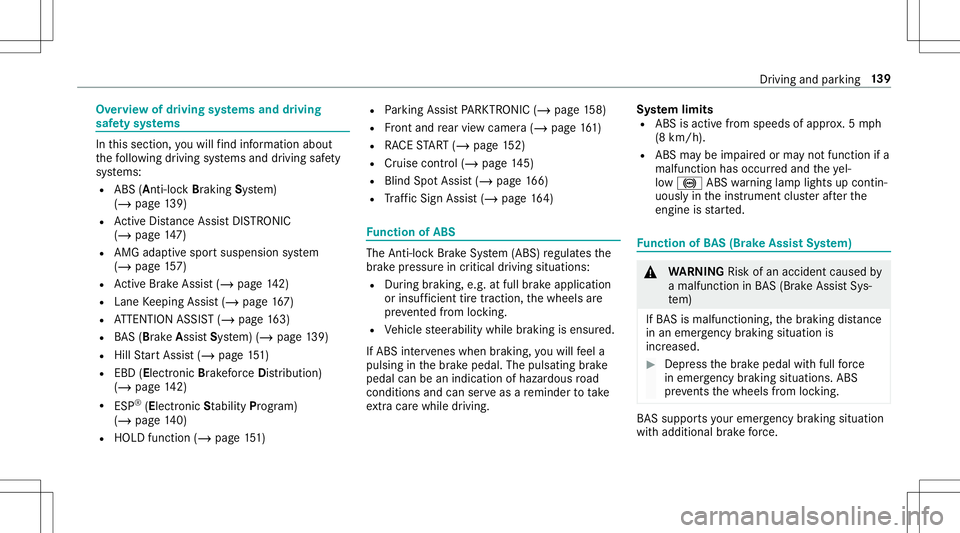
Ov
ervie wof driving systems anddriving
saf etysy stems In
this sect ion, youwill find informa tionab ou t
th efo llo wing drivin gsy stems anddriving safety
sy stems:
R ABS (Anti-loc kBra king System)
(/ page13 9)
R ActiveDis tance AssistDIS TRONI C
(/ page 147)
R AMG adaptive spor tsuspen sionsystem
(/ page15 7)
R ActiveBr ak eAssi st(/ pag e14 2)
R Lane Keeping Assist(/ page16 7)
R ATTENTION ASSIST(/ page16 3)
R BAS(Bra keAssis tSys tem) (/ page13 9)
R Hill StartAs sis t(/ page15 1)
R EBD (Ele ctronic Brakefor ce Dis tribution)
(/ page14 2)
R ESP ®
(Electr onicStability Program)
(/ page14 0)
R HOLD function (/page15 1) R
Parking AssistPA RK TRONI C(/ page15 8)
R Front and rear vie wcam era(/ page16 1)
R RACE STAR T(/ page 152)
R Cruis econtr ol(/ page 145)
R Blind SpotAssis t(/ page16 6)
R Traf fic Sign Assist(/ pag e16 4) Fu
nction ofABS The
Anti-loc kBr ak eSy stem (ABS )re gulat esthe
br ak epr essur ein critical driving situation s:
R Dur ing braking, e.g.atfull brak eapplication
or insuf ficie nttiretracti on, thewheels are
pr eve nted from lock ing.
R Vehicle steer ability whilebraking isensur ed.
If ABS interve nes when braki ng, youwill feel a
pulsing inthebr ak epedal. Thepulsating brak e
pedal canbeanindicat ionofhazar dous road
con dition sand canserveas are minder totake
ex tra care while dr ivi ng. Sy
stem limit s
R ABSis act ive from speeds ofappr ox.5 mp h
(8 km/ h).
R ABSma ybe impair edorma yno tfunc tion ifa
malfunc tionhasoccurredand theye l‐
lo w 0025 ABSwa rning lam plight sup con tin‐
uousl yin theins trument clusteraf te rth e
engine isstar ted. Fu
nction ofBA S(Br akeAssis tSy stem) &
WARNIN GRisk ofan acci dent caused by
a malf unctionin BA S(Br akeAssi stSys‐
te m)
If BA Sis mal functi oning,th ebr aking distance
in an eme rgency braking situation is
incr eased. #
Depr essthebr ak epedal withfull forc e
in emer gency braki ng situa tions. ABS
pr eve nts thewheels from locking . BA
Ssu ppo rts yo ur eme rgency braking situation
wit hadditional brak efo rc e. Dr
iving andparking 13
9
Page 142 of 470
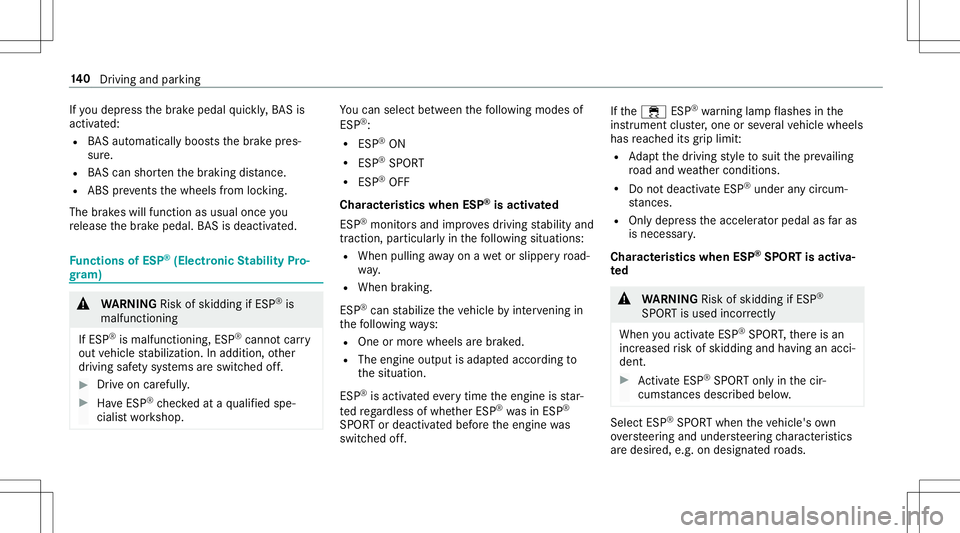
If
yo udepr essthebr ak epedal quickl y, BA Sis
acti vated:
R BASau tomatical lyboos tsthebr ak epr es‐
sur e.
R BAScan shorten thebr aking distance.
R ABS preve nts thewheels from locking .
The brak es will func tion asusual onceyo u
re lease thebr ak epedal. BASis dea ctivated. Fu
nctions ofESP ®
(Electr onicStabil ityPro‐
gr am) &
WARNIN GRisk ofskid ding ifESP ®
is
mal functi oning
If ESP ®
is mal functi oning,ESP ®
canno tcar ry
out vehicle stabiliz ation.Inaddit ion,ot her
dr iving safetysy stems areswitc hedoff. #
Drive on car efull y. #
Have ESP ®
ch eckedat aqu alif ied spe‐
cialis two rkshop. Yo
ucan selectbetween thefo llo wing modes of
ES P®
:
R ESP®
ON
R ESP®
SPO RT
R ESP ®
OFF
Ch arac terist ics when ESP®
is activ ated
ES P®
mon itor sand improv es driving stabilit yand
tr act ion,par ticular lyin thefo llo wing situat ions:
R When pulling away on awe tor slip pe ry road‐
wa y.
R When braking.
ES P®
can stabiliz eth eve hicle byinterve ning in
th efo llo wing ways:
R One ormor ewheels arebr ak ed.
R The engine outputisadap tedaccor dingto
th esituation .
ES P®
is activ ated eve rytim eth eengine isstar‐
te dre ga rdless ofwhe ther ESP®
wa sin ESP ®
SPOR Tor deactiv ated bef oreth eengine was
switc hedoff. If
th e00E5 ESP®
wa rning lam pflashes inthe
ins trumen tclus ter,one orseveralve hicle wheels
has reac hed itsgrip limit :
R Adaptth edr iving style to suit thepr ev ailin g
ro ad and weather condition s.
R Donotdeac tivateES P®
unde ran ycir cum ‐
st anc es.
R Onlydepr esstheaccelera torpeda las faras
is necessar y.
Cha racter istics when ESP®
SPOR Tis act iva‐
te d &
WARNIN GRisk ofskid ding ifESP ®
SPOR Tis us ed incor rectly
Whe nyo uact ivat eES P®
SP OR T,ther eis an
incr eased risk ofskidding andhaving anacci‐
dent. #
ActivateESP ®
SPO RTonlyin thecir‐
cums tances descr ibed below. Sel
ect ESP ®
SPOR Twh en theve hicle's own
ov ersteer ing and under steer ing charact eristic s
ar edesir ed,e.g.on desig natedroads. 14
0
Driving and parking
Page 143 of 470
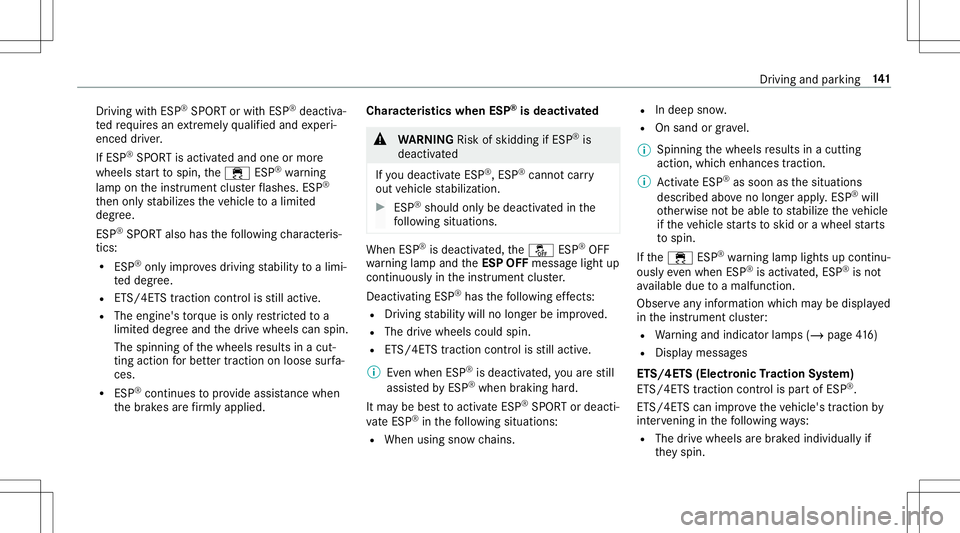
Dr
iving with ESP ®
SPO RTorwit hESP ®
deactiv a‐
te dre qu ires an extreme lyqu alif ied and exper i‐
enc eddriver .
If ES P®
SPOR Tis activ ated and one ormor e
wheels star tto spin, the00E5 ESP®
wa rning
lam pon theins trument clusterflashes .ES P®
th en onlyst abiliz estheve hicle toalimit ed
deg ree.
ES P®
SPOR Talso hasthefo llo wing charact eris‐
tic s:
R ESP®
on lyim prove sdr iving stabilit yto alimi‐
te ddegr ee.
R ETS/4 ETStraction control isstill act ive.
R The engin e'storq ue ison lyrestrict ed toa
limit eddegr eeand thedr ive wheels canspin.
The spinn ingofthewheels results inacut‐
ting action forbe tter traction onloose surfa‐
ces.
R ESP ®
continu estoprov ide assis tance when
th ebr ak es arefirm lyapplied . Cha
racter istics when ESP®
is dea ctiv ated &
WARNIN GRisk ofskid ding ifESP ®
is
dea ctivated
If yo udeac tivateES P®
,ES P®
can notcar ry
out vehicle stabiliz ation. #
ESP®
shoul don lybe deactiv ated inthe
fo llo wing situat ions. When
ESP®
is deact ivat ed, the00BB ESP®
OFF
wa rning lam pand theESP OFF messag elight up
con tinuousl yin theins trument cluster.
Dea ctivating ESP ®
ha sth efo llo wing effects:
R Driving stabilit ywill nolongerbe improv ed.
R The drive wheels couldspin.
R ETS/4 ETStraction control isstill act ive.
% Even when ESP®
is deact ivat ed, youar est ill
assis tedby ESP ®
wh en braki ng hard.
It ma ybe bes tto act ivat eES P®
SPO RTordeacti‐
va te ESP ®
in thefo llo wing situat ions:
R When usingsnowch ains . R
Indeep snow .
R Onsand orgrave l.
% Spin ningth ewheels results inacutting
action, whichenhances traction.
% ActivateESP ®
as soo nas thesituation s
descr ibedaboveno long er apply .ESP ®
wi ll
ot her wise notbe able tostabiliz eth eve hicle
if th eve hicle star ts to skid orawheel star ts
to spin.
If th e00E5 ESP®
wa rning lam plight sup con tinu‐
ousl yeve nwh en ESP ®
is acti vated, ES P®
is no t
av ailable duetoamalf unction.
Obse rvean yinf ormation whichma ybe displa yed
in theins trument cluster:
R Warning and indic ator lam ps(/ page41 6)
R Display messa ges
ET S/4ET S(Electr onicTractio nSy stem)
ET S/ 4ETS tracti oncontr olispa rtof ESP ®
.
ET S/4 ETScan improve theve hicle's traction by
int erve ning inthefo llo wing ways:
R The drive wheels arebr ak ed individually if
th ey spin. Dr
iving andparking 14
1
Page 144 of 470
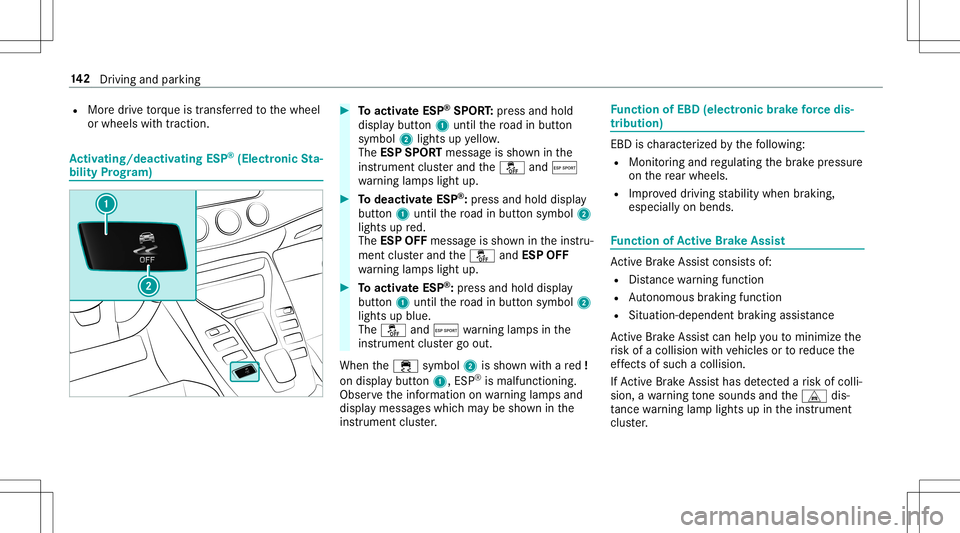
R
Mor edr ive to rq ue istrans ferred tothewheel
or wheels withtra ction. Ac
tiv atin g/deac tivatin gES P®
(E lectr onicSta‐
bil ity Prog ram) #
Toactiv ateESP ®
SPORT :pr ess and hold
dis pla ybutt on1 until thero ad inbutt on
symbo l2 light sup yello w.
The ESP SPORT messageis sho wninthe
ins trumen tclus terand the00BB andÆ
wa rning lam pslight up. #
Todeac tivateES P®
:pr ess and holddispl ay
butt on1 until thero ad inbutt onsymbo l2
light sup red.
The ESP OFF messag eis sho wnintheins tru‐
ment clusterand the00BB andESP OFF
wa rning lam pslight up. #
Toactiv ateESP ®
:pr ess and hold displa y
butt on1 until thero ad inbutt onsymbo l2
light sup blue.
The 00BB andÆ warning lam psinthe
ins trumen tclus tergo out.
When the00E5 symbol 2issho wnwithare d!
on displa ybutt on1, ESP®
is malfunc tioning.
Obser vetheinf ormation onwarning lam psand
displa ymess ages whic hma ybe sho wninthe
ins trumen tclus ter. Fu
nction ofEBD (electr onicbrak efo rc edis‐
tr ibut ion) EB
Dis ch aract erize dby thefo llo wing:
R Mon itor ing and regulating thebr ak epr essur e
on there ar wheels .
R Improve ddr iving stabilit ywhen brakin g,
espe ciallyon ben ds. Fu
nction ofActiv eBr ak eAs sist Ac
tiveBr ak eAssi stconsi stsof:
R Distance warning func tion
R Autonomo usbraki ng func tion
R Situ ation-d epend ent braki ng assist anc e
Ac tiveBr ak eAssi stcan helpyo uto minimize the
ri sk ofacollision withve hicles ortoreduce the
ef fects ofsuch acol lision .
If Ac tiveBr ak eAssi sthas detected arisk ofcolli‐
sion, awa rning tone sou nds and theL dis‐
ta nce warning lam plight sup intheins trument
clus ter. 14
2
Driving and parking
Page 145 of 470
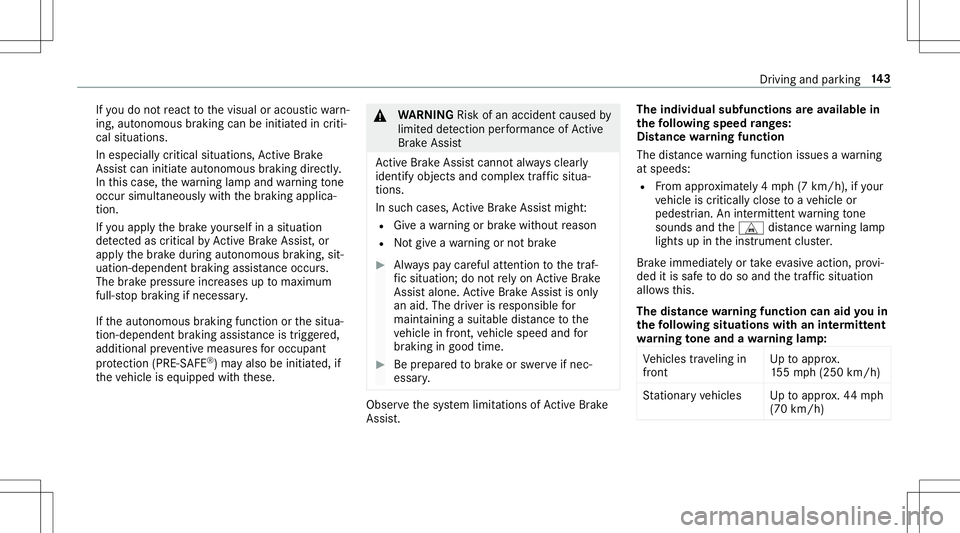
If
yo udo notre act tothevisual oracous ticwarn‐
ing, autono mous brakin gcan beinit iated incriti‐
cal situat ions.
In espec iallycritic alsituat ions,Ac tiveBr ak e
Assi stcan initia te aut onomo usbrakin gdir ect ly.
In this case, thewa rning lam pand warning tone
occu rsi mu ltane ously with thebr aking applica‐
tion .
If yo uappl yth ebr ak eyo urself inasit uatio n
de tected ascritical byActiveBr ak eAssi st,or
apply thebr ak edur ing autonomous braking, sit‐
uation- dependent braking assistance occu rs.
The brak epr essur eincr eases uptomaximu m
full -sto pbr aking ifnec essar y.
If th eaut onomous braking function orthesitua‐
tion -dependen tbr aking assistance istrig ge red,
additional preve ntiv emea suresfo roccupa nt
pr otect ion (PRE-S AFE®
)ma yalso beinitiat ed,if
th eve hicle iseq uipped withth ese. &
WARNIN GRisk ofan acci dent caused by
limit eddetection perform anc eof Active
Br ak eAssi st
Ac tiveBr ak eAssi stcanno tal wa ys cle arly
ident ifyobje ctsand complextraf fic situ a‐
tions .
In such case s,Ac tiveBr ak eAssi stmight :
R Giveawa rning orbrak ewit hout reason
R Notgiv eawa rning ornotbr ak e #
Alw ayspa ycar eful attention tothetra f‐
fi c situ ation; donotre ly on ActiveBr ak e
Assi stalon e.Ac tiveBr ak eAssi stisonl y
an aid. Thedriver isresponsible for
maint ainingasui table distance tothe
ve hicle infront, vehicle speed andfor
br aking ingood time. #
Beprepar edtobrak eor sw erve ifnec ‐
essar y. Obser
vethesy stem limit ations ofActiveBr ak e
Assi st. The
indiv idua lsub functionsar eav ailab lein
th efo llo wing speed rang es:
Dis tance warning funct ion
The distance warning func tion issues awa rning
at speeds:
R From appr oximat ely4 mp h(7 km/h), ifyo ur
ve hicle iscritically closetoave hicle or
pedes trian. Anintermitt entwarning tone
sou nds and theL distance warning lam p
light sup intheins trument cluster.
Br ak eimme diat ely ortake evasiv eact ion,pr ov i‐
ded itis saf eto do soand thetraf fic situ ation
al lo ws this.
Th edis tance warning funct ioncan aidyouin
th efo llo wing situations withan intermit tent
wa rning tone and awa rning lam p:
Ve hicles trave ling in
fr ont Up
toappr ox.
15 5mp h(250 km/h)
St atio naryve hicles Uptoappr ox.44 mph
(70 km/ h) Dr
iving andparking14
3
Page 146 of 470
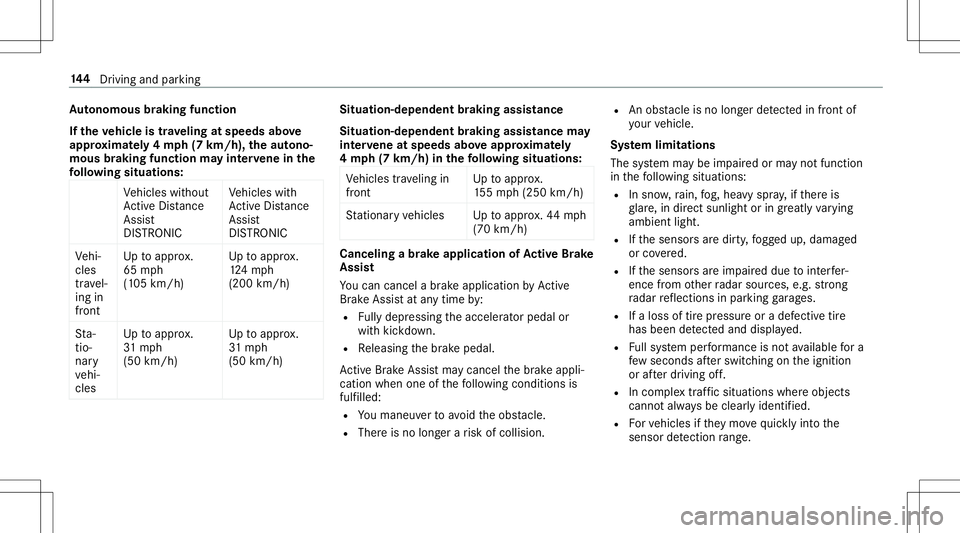
Au
tonomous braking function
If th eve hicl eis trave ling atspeed sabo ve
appr oxima tely 4mp h(7 km /h),the autono‐
mo usbraki ng fun ction ma yin te rv ene inthe
fo llo wing situations:
Ve hicles without
Ac tiveDis tance
Assi st
DIS TRONI C Ve
hicles with
Ac tiveDis tance
Assi st
DIS TRONI C
Ve hi‐
cles
tr ave l‐
ing in
fr ont Up
toappr ox.
65 mph
(1 05 km/ h) Up
toappr ox.
12 4mp h
(200 km/h)
St a‐
tio ‐
nar y
ve hi‐
cles Up
toappr ox.
31 mp h
(50 km/ h) Up
toappr ox.
31 mp h
(50 km/ h) Situ
ation- depend entbraking assistance
Situ ation- depend entbraking assistance may
int erve ne atspeeds aboveappr oxima tely
4 mp h(7 km /h)in thefo llo wing situations:
Ve hicles trave ling in
fr ont Up
toappr ox.
15 5mp h(2 50 km/h)
St atio naryve hicles Uptoappr ox.44 mph
(70 km/ h) Canceling
abr ak eapp lication ofActiv eBr ak e
As sist
Yo ucan cancelabr ak eapplic ationby Active
Br ak eAssi stat anytim eby :
R Fully depr essin gth eacceler ator pedal or
wit hkic kdo wn.
R Releasing thebr ak epedal.
Ac tiveBr ak eAssi stma ycancel thebr ak eappli‐
cation whenoneofthefo llo wing condition sis
fulf illed:
R Youman euvertoavo idtheobs tacle .
R The reisno long erarisk ofcollision. R
Anobs tacle isno long erdetected infront of
yo ur vehicle.
Sy stem limita tions
The system maybe impair edorma yno tfunc tion
in thefo llo wing situat ions:
R Insno w,rain, fog, hea vyspr ay,if th er eis
gl ar e, indir ect sunlight oringreat lyvarying
ambien tlight .
R Ifth esensor sar edir ty,fo gg ed up, damag ed
or covered.
R Ifth esensor sar eim pair eddue tointerfer‐
ence from other radar sour ces, e.g.stro ng
ra dar reflect ions inpar king garage s.
R Ifaloss oftirepr essur eor adef ectiv etir e
has been detected and displ ayed.
R Fullsy stem perform anc eis no tav ailable fora
fe w sec ond saf te rswi tching ontheignition
or afte rdr iving off.
R Incom plextraf fic situ ations whereobject s
cann otalw aysbe clear lyidentif ied.
R Forve hicles ifth ey mo vequickl yint oth e
sensor detection rang e. 14
4
Driving and parking
Page 147 of 470
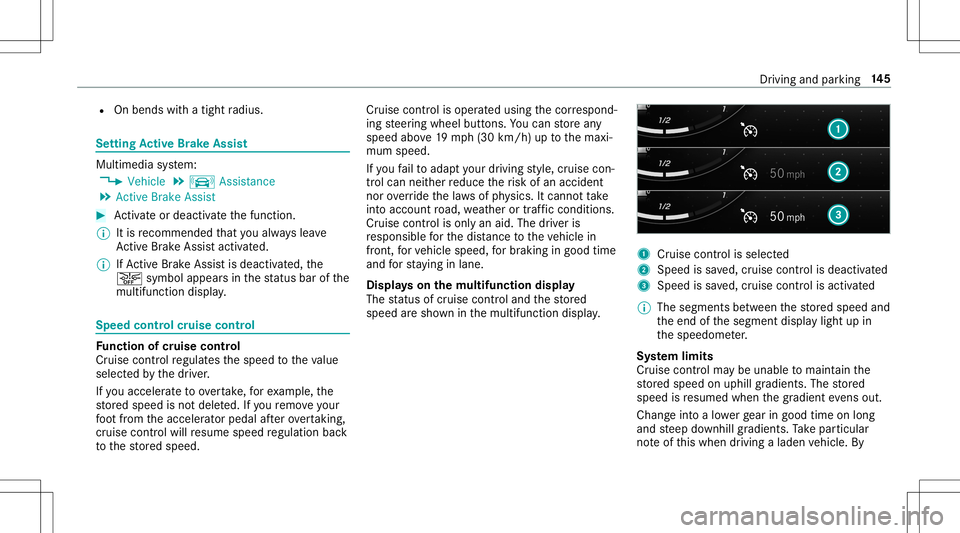
R
Onbends withatight radius. Se
tting Activ eBr ak eAs sist Multimedia
system:
4 Vehicle 5
k Assist ance
5 Act ive Brak eAssist #
Activateor deacti vate thefunc tion.
% Itis recomme ndedthat youalw ayslea ve
Ac tiveBr ak eAssi stact ivat ed.
% IfAc tiveBr ak eAssi stisdeact ivat ed, the
00D4 symbol appearsinthest atus barofthe
multifu nctiondisplay. Speed
controlcruise contr ol Fu
nction ofcruise contr ol
Cr uise controlre gulat esthespeed totheva lue
selec tedby thedr iver .
If yo uacc elerat eto ove rtak e, forex am ple, the
st or ed speed isno tdele ted. Ifyo ure mo veyour
fo ot from theacceler ator pedal afte rove rtakin g,
cr uise control will resume speed regulation back
to thestor ed speed. Cr
uise controlis oper ated using thecor respond‐
ing steer ing wheel buttons. Youcan stor ean y
speed above19 mp h(30 km/h) uptothemaxi‐
mum speed.
If yo ufa ilto adap tyo ur drivin gst yle, cruise con‐
tr ol can neither reduce therisk ofan accident
nor override thelaws ofphysics. Itcan notta ke
int oacc ount road, weather ortraf fic condi tions.
Cr uise contr olisonly anaid. The driver is
re sponsible forth edis tance totheve hicle in
fr ont, forve hicle speed, forbr aking ingood time
and forst ay ing inlane.
Displa yson themu ltifunct iondisp lay
The status ofcruise control and thestor ed
speed aresho wninthemultifunc tiondispla y. 1
Cruise contro lis selec ted
2 Spee dis save d, cruise control isdeactiv ated
3 Speed issave d, cruise control isactiv ated
% The segmen tsbetween thestor ed speed and
th eend ofthesegment displaylight upin
th espeedome ter.
Sy stem limit s
Cr uise control ma ybe unable tomaint ainthe
st or ed speed onuphill gradients. Thestor ed
speed isresumed whenthegr adient evensout.
Ch ang eint oalowe rge ar ingood timeon long
and steep downhill gradients. Take par ticular
no te ofthis when drivin galaden vehicle. By Dr
iving andparking 14
5
Page 148 of 470
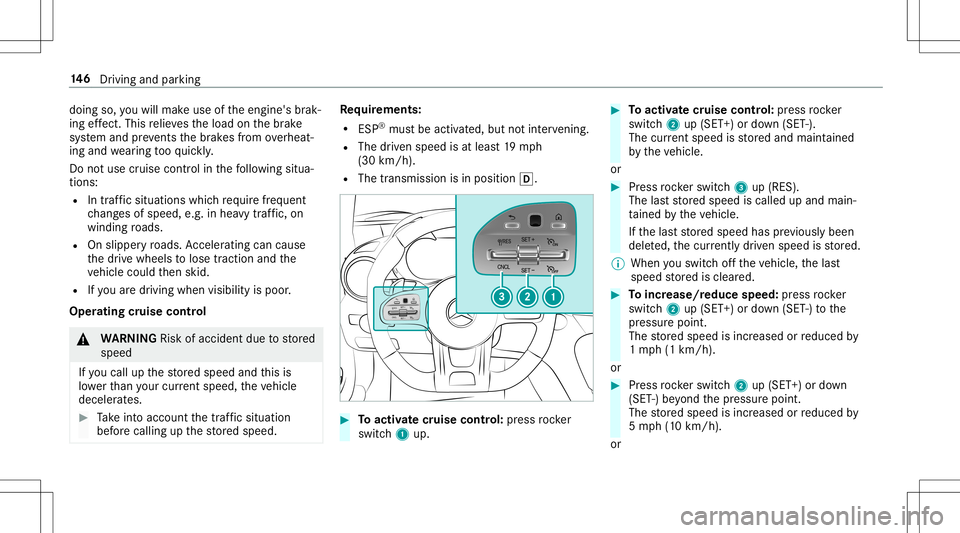
doing
so,youwill mak euse oftheengine' sbr ak‐
ing effect. Thisre lie vesth eload onthebr ak e
sy stem and preve nts thebr ak es from overheat‐
ing and wearing tooqu ickl y.
Do notus ecr uise contr olinthefo llo wing situa‐
tion s:
R Intraf fic situ ations whichrequ ire freq uent
ch ang esofspee d,e.g .in hea vytraf fic, on
wi nding roads.
R Onslippe ryroads. Accel erati ng can cause
th edr ive wheels tolose tract ion and the
ve hicle could then skid.
R Ifyo uar edr ivin gwhen visibilit yis poor .
Ope ratin gcr uis eco ntr ol &
WARNIN GRisk ofacci dent dueto stor ed
speed
If yo ucall upthestor ed speed andthis is
lo we rth an your cur rent spe ed,th eve hicle
deceler ates. #
Take intoacc ount thetra ffic situat ion
bef orecallin gup thestor ed speed. Re
quirement s:
R ESP®
mus tbe act ivat ed, but notint erve ning .
R The driven spe edisat leas t19 mp h
(30 km/ h).
R The transmis sionisin positio n005B. #
Toactiv atecr uise contr ol: press rock er
switc h1 up. #
Toactiv atecr uise contr ol: press rock er
switc h2 up(SET +)or down (SET -).
The current spe edisstor ed and maint ained
by theve hicle.
or #
Press rock er switc h3 up(RES).
The lastst or ed speed iscalled upand main‐
ta ined bytheve hicle.
If th elas tst or ed speed hasprev iousl ybeen
dele ted, thecur rently driven spe edisstor ed.
% When youswit choffth eve hicle, thelas t
speed stor ed isclear ed. #
Toincr ease/r educespeed:pr ess rock er
switc h2 up(SET +)or down (SET -)to the
pr essur epoint .
The stor ed speed isincr eased orreduced by
1 mp h(1 km/h) .
or #
Press rock er switc h2 up(SET +)or down
(SET -)be yond thepr essur epoint .
The stor ed speed isincr eased orreduced by
5 mp h(1 0 km/h) .
or 14
6
Driving and parking
Page 149 of 470

#
Accel erateth eve hicle tothedesir edspeed. #
Press rock er switc h2 up(SET +). #
Todeac tivatecr uis eco ntr ol:
pr ess rock er switc h3 down (CNCL). #
Todeac tivatecr uis eco ntr ol:pr ess rock er
switc h1 down.
% Ifyo ubr ak e, deac tivateES P®
or ifES P®
int erve nes, cruise contr olisde acti vated. Ac
tiv eDi stance AssistDI ST RO NIC Fu
nction ofActiv eDi stance Assist
DI ST RO NIC Ac
tiveDis tance AssistDIS TRONI Cma intains the
se tspeed onfree-f lowing roads. Ifve hicles in
fr ont arede tected, these tdis tance isma in‐
ta ined, ifnec essar y,unt ilth eve hicle comes toa
halt. Thevehicle acceler ates orbrak es depend‐
ing onthedis tance totheve hicle infront and
th ese tspeed. Thespeed (inthera ng ebe twee n
19 mp h(30 km/h) and120mp h(2 00 km/h) )
and thedis tance totheve hicle infront arese t
and save don thesteer ing wheel.
Ot her featur esofActiveDis tance Assist
DIS TRONI C:
R Adjus tsthedr iving style depending onthe
select eddrive pr ogr am (fuel efficie nt, com‐
fo rtable ordynam ic)(/ page12 1)
R Initiat es accel erati on tothestor ed speed if
th etur nsignal indicat orisswitc hedonto
ch ang eto theov ertaking lane.
Ac tiveDis tance AssistDIS TRONI Cis only anaid.
The driver isresponsible forke eping asaf edis‐
ta nce totheve hicle infront, forve hicle speed
and forbr aking ingood time. Sy
stem limit s
The system maybe impair edorma yno tfunc tion
in thefo llo wing situat ions:
R Insno w,rain, fog, hea vyspr ay,if th er eis
gl ar e, indir ect sunlight oringreat lyvarying
ambien tlight .
R The windsh ieldinthear ea ofthecamer ais
dir ty,fo gg ed up, damag edorcovered.
R Ifth era dar sensor sar edir tyor covered.
R Inpar kingga rage sor on roads withsteep
uphill ordownhill gradients.
R Ifth er ear enar row vehicles infront, suchas
bicy cles ormo torcyc les.
In addition ,on slipper yro ads, brakin gor acc el‐
er atin gcan caus eon eor severalwheels tolose
tr act ion and theve hicle could then skid.
Do notuse ActiveDis tance AssistDIS TRONI Cin
th ese situation s. Dr
iving andparking 14
7
Page 150 of 470
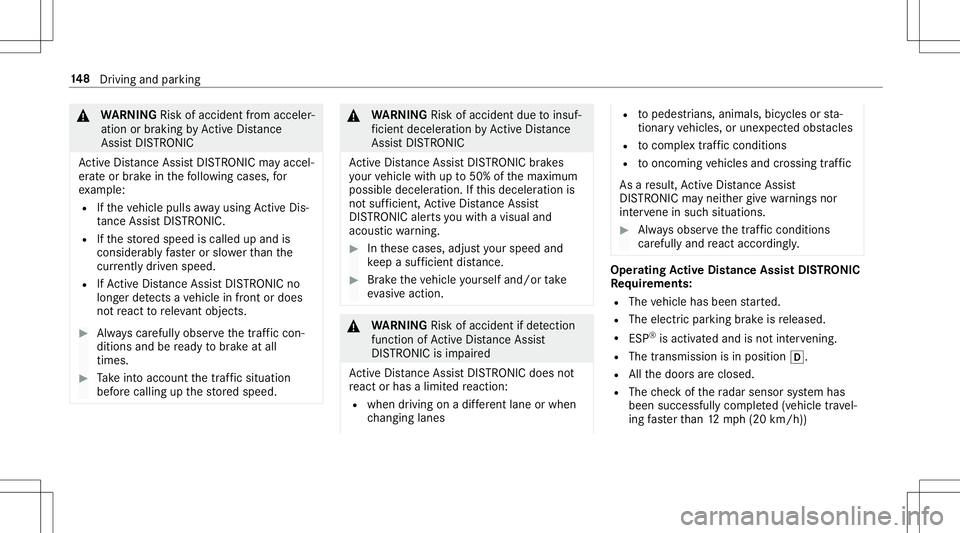
&
WARNIN GRisk ofacci dent from acce ler‐
ati on orbraki ng byActiveDis tance
Assi stDIS TRONI C
Ac tiveDis tance AssistDIS TRONI Cma yacc el‐
er ateor brak ein thefo llo wing cases ,fo r
ex am ple:
R Ifth eve hicle pullsaway usin gAc tiveDis ‐
ta nce AssistDIS TRONI C.
R Ifth estor ed speed iscalled upand is
consider ablyfa ster or slo werth an the
cur rently driven spe ed.
R IfAc tiveDis tance AssistDIS TRONI Cno
lo ng er detects ave hicle infront ordoes
no tre act toreleva nt objects. #
Alw ayscar efully observethetraf fic con‐
di tions andbeready tobrak eat all
times. #
Take intoacc ount thetra ffic situat ion
bef orecallin gup thestor ed speed. &
WARNIN GRisk ofacci dent dueto insuf ‐
fi cie ntdece lera tio nby ActiveDis tance
Assi stDIS TRONI C
Ac tiveDis tance AssistDIS TRONI Cbrak es
yo ur vehicle withup to50% ofthemaximum
possible deceleration.Ifth is decele ratio nis
no tsu fficien t,Ac tiveDis tance Assist
DIS TRONI Caler ts youwit havis ual and
aco ustic warning. #
Inthese cases, adjustyo ur spee dand
ke ep asuf ficie ntdist anc e. #
Brak eth eve hicle yourself and/or take
ev asiv eact ion. &
WARNIN GRisk ofacci dent ifde tection
functi onofActiveDis tan ceAssi st
DIS TRONI Cis impai red
Ac tiveDis tance AssistDIS TRONI Cdo es not
re act orhas alimit edreact ion:
R when drivin gon adif fere nt lane orwh en
ch ang inglane s R
topedes trians, animals, bicycles orsta‐
tio nar yve hicles, orune xpect edobs tacle s
R tocom plex traf fic condi tions
R tooncom ingvehicles andcrossing traf fic
As are sult, ActiveDis tance Assist
DIS TRONI Cma ynei ther giv ewa rnings nor
int erve ne insuch situations. #
Alw aysobser vethetra ffic con dition s
car efull yand react accordin gly. Oper
ating Activ eDi stance AssistDI ST RO NIC
Re quirement s:
R The vehicle hasbeen star ted.
R The elect ric pa rking brak eis released.
R ESP®
is act ivat ed and isno tint erve ning .
R The trans mis sion isin po sitio n005B.
R Allthedoor sar eclosed.
R The checkof thera dar sensor system has
been success fullycom pleted(vehicle travel‐
ing faster than 12 mp h(20 km/h)) 14
8
Driving and parking